Paste is a broad term for viscous, semi-solid products (creams, lotions, sauces, gels) consisting of granular materials suspended in a fluid. Such pastes behave like solids at rest but flow under stress. Common examples include cosmetic creams, toothpastes, peanut butter, ketchup, and pharmaceutical ointments. Paste viscosities can vary tremendously – from only a few hundred cP (centipoise) to several hundred thousand cP. For context, water is about 1cP, honey around 10,000cP, and thick peanut butter ~250,000cP. These high viscosities and often non-Newtonian rheologies (shear-thinning, yield stress) make filling paste particularly challenging: the material may cling to lines, trap air bubbles, require high pressure to pump, and risk dripping after dispensing. Specialized paste filling machines are engineered to handle these challenges with appropriate pumping, venting, and sealing systems.
Pastes come in many formulations: thick lotions, cosmetic creams, ointments, sauces, condiments, adhesives, sealants, etc. Packaging these requires precision (to fill by volume or weight) and care to avoid entrapped air. For example, long-chain polymers or particulates in a paste can clog small nozzles, so pump-based fillers often meter by volume or time. In short, a paste filler must be built for high viscosity and sometimes abrasive or sticky products.
Common Paste Packaging Containers
Paste products are filled into a variety of containers depending on the market:
● Tubes: Laminated plastic or metal tubes (often aluminum) ranging from a few grams (travel-size) up to ~200mL. These are common for toothpaste, cosmetic creams, ointments, and food items (mustard, mayonnaise). Tubes are typically filled by a special tube filling and sealing machine: an empty tube is indexed under a filling nozzle, filled with paste, then heat-sealed or crimped at the end. Tube fillers can handle laminate or aluminum tubes and often trim off excess material for a neat finish.
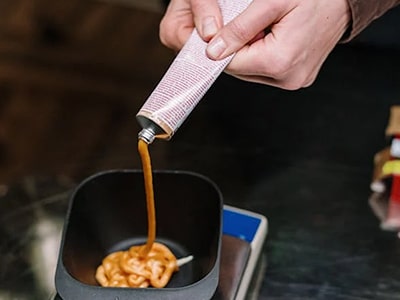
● Jars and Tubs: Wide-mouth jars (plastic like PET/PP, or glass) from small (10–50mL) up to larger (250mL–5L) sizes. Jars are popular in cosmetics (face creams, body butter), food (jam, peanut butter), and pharmaceuticals (powders, ointments). They usually require leveling (the paste surface is leveled after filling) and secure capping (screw caps, induction seals) to preserve freshness. Containers may be glass or plastic – glass jars often give a premium look, while plastic jars are lightweight and shatterproof.

● Bottles: Rigid bottles (PET, HDPE, PP) with narrow or wide necks, typically 50mL to 2L. Unlike jars, bottles are easier to handle on conveyors. Bottles need filling heads (often submerged nozzles) to prevent splashing of thick paste. After filling, bottles are capped or sealed (screw caps, pump dispensers, droppers). Image: Robotic paste fillers often connect to bottle conveyors, as shown below, to fill creams or sauces into rows of bottles.
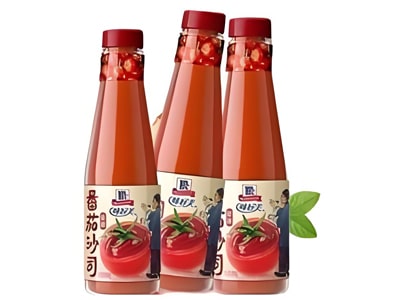
● Pouches and Sachets: Flexible pouches (stand-up spouted pouches or flat sachets) ranging from single-use (5–20mL) to larger (1–5kg) bulk pouches. These require pouch-specific equipment. Premade pouch fillers fill pre-formed, pre-sealed pouches with paste through a filler and then seal the pouch (often by heat sealing). Pouches are popular for sauces, condiments, creams, and personal-care gels. They save packaging costs and allow easy dispensing at the consumer end.
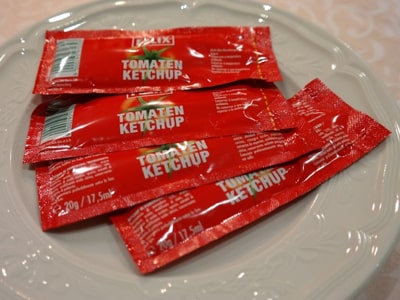
● Others: Specialty vessels like squeeze bottles, cartridges, and syringes (for creams, adhesives) or bulk drums (industrial greases) may also be filled using paste-filler systems or related machines.
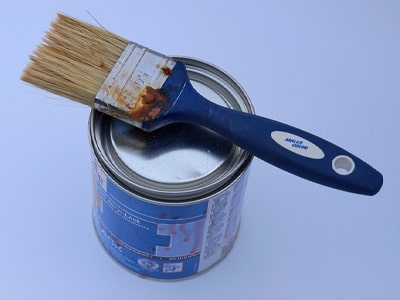
Each container type imposes its own requirements (e.g. tube sealing vs jar capping, pouch heat-seal), so compatibility is key. For example, squeeze tubes need a crimp or heat-seal at the tail end, while jars need clean leveling and capping. The material (plastic vs metal vs glass) and size range also affect nozzle design and conveyor handling.
Paste Filling Machine Types and Features
Paste filling machines come in many styles depending on automation level and filling mechanism. The main categories are manual/semi-automatic versus fully automatic systems, and by pump mechanism (piston vs pump vs auger, etc.). A comparative summary is shown in the table below:
| Type | Operation | Speed (cont./min) | Accuracy | Applications/Notes |
|---|---|---|---|---|
| Manual/Pedestal Filler | Manual (hand or foot) | Very low (≈1–10) | Moderate (user-controlled) | Small batches, labs, R&D. Simple piston or syringe style fillers. Portable benchtop units. Suitable for startups or niche products (e.g. 5–25 bottles/min small cream filler). |
| Semi-Automatic Piston | Semi-auto (operator loads containers; usually pneumatic or electric drive) | ≈10–50 | High (mechanical dosing) | Medium volume. Single or few filling heads. Common for cosmetics jars, tubes, condiment bottles. Often foot-pedal or push-button triggered. Requires operator to move containers. |
| Fully Automatic Rotary Piston | Fully-automatic (indexed rotary or continuous) | ≈300–1000 (up to >1000 in multi-head) | Very high (servo/pump controls) | High-volume lines. Rotary tables or inline conveyors with many nozzles. Precision piston dosers for creams, sauces, ointments, etc. Integrates with conveyors and cappers. For toothpaste, lotions, food spreads. Often servo-driven for +/-0.25% accuracy. |
| Single- or Multi-Head Pump Filler | Semi/Auto (diaphragm or lobe pumps) | Single-head: ~10–100; Multi-head: 100–600+ | High (pump displacement control) | Handles extreme viscosities & particulates. Lobe pump or peristaltic pump drives viscous paste (cosmetics, food sauces, lubricants). Multi-nozzle (servo) versions can fill 1000+ cpm. Good for thick sauces, adhesives. |
| Pouch/Tubular Filler | Fully-automatic | High (varies by model) | High | For pouches and tubes. Fills and seals in one machine. Adjusts for pouch sizes or tube diameters. Example: pouch filler for ketchup packets; rotary tube filler for toothpaste. |
Each type has trade-offs. Manual or tabletop fillers (often pneumatic or simple piston) are low-cost and flexible but very slow. Semi-automatic piston fillers are more common in small plants: they fill by a programmable piston but still need an operator to place containers. Fully automatic rotary piston machines use a multi-station turret (or inline indexing) to fill many containers per revolution, achieving very high throughput. For example, a 16-nozzle rotary piston filler can easily exceed 1000 bottles/min. These systems often include servo drives for precise control.
Pump-based fillers (rotary lobe or peristaltic pumps) are another category. A single-head pump filler might be semi-auto; a multi-head pump filler is typically part of a high-speed line. Pumps can self-prime thick paste and meter by pump volume or time. They excel at products with particulates (smooth honey vs chunky peanut sauce) because the pump moves the product mechanically, rather than relying on it flowing through a valve. Ceramic plunger pumps are a sub-type: their pistons are made of ceramic for extra hardness and wear resistance, so they last longer with abrasive or chemical pastes.
Manual vs Automatic: In general, manual (hand/foot) and tabletop piston fillers cost much less (tens of thousands USD) but produce only a few cpm. Semi-automatic machines (single-head, operator-fed) are mid-cost and suitable for small to medium runs. Fully automatic machines (multi-head, conveyor-fed) are more expensive but deliver the highest speed and consistency. For example, SFXB notes that an automatic line can integrate filling, capping, and labeling to create a seamless production system.
Semi-Automatic vs Fully Automatic
● Semi-Automatic Paste Filling Machine: These machines automate the piston or pump dosing but still require an operator to place and remove containers. Speeds are modest (often <40 cpm). They often use pneumatic cylinders and simple controls. A semi-auto piston filler might have one or two nozzles; a single operator can achieve precise fills with minimal training. These units can be built as tabletop or floor models. Semi-automatic paste fillers are ideal for low-volume or variable-run production. Because the operator handles parts, they are easier to change over for different container sizes. They also typically cost less up-front.
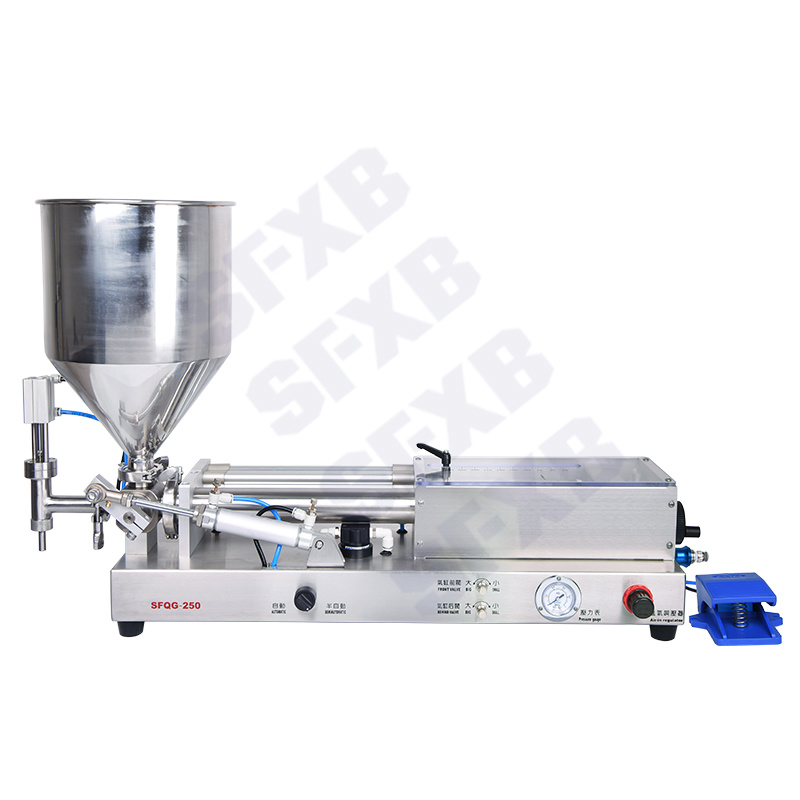 |
SFQG series single head fully pneumatic paste filling machine (explosion-proof)
● Food, pharmacy, cosmetics, oil, daily chemical and other paste, sauce, liquid filling; |
● Fully Automatic Paste Filling Machine: Fully automatic lines require no manual placement: containers are fed by conveyor, indexed under filling heads, then moved to capping/labeling stations. These machines achieve much higher output (hundreds to thousands of units per hour) and greater repeatability. They may use multiple piston or pump heads, vision sensors for part detection, and integrated wrapping lines. Naturally, they are more complex and costly. As SFXB notes, automatic machines can be integrated with cappers and labelers to form a turnkey packaging line. They are suited to high-volume food, cosmetic, or pharmaceutical production.
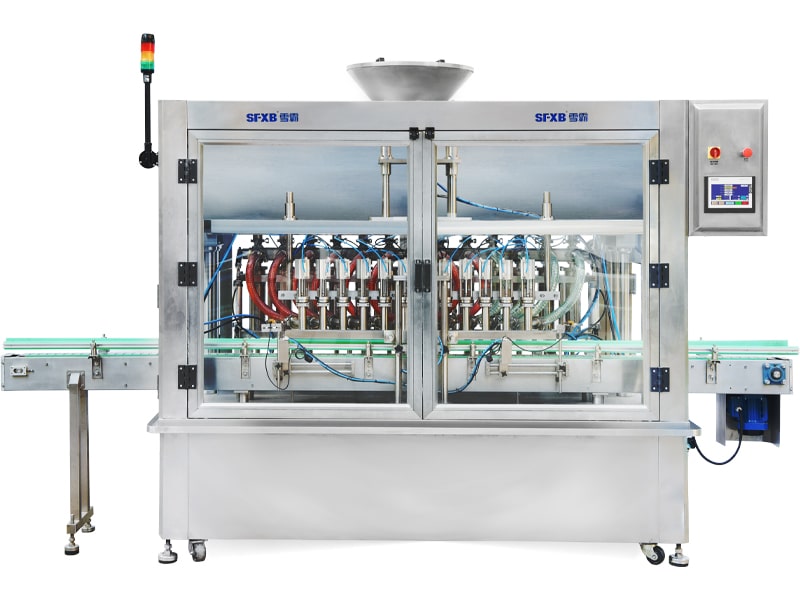 |
| XBGZ-500-12 12-head Frequency Conversion Servo Drive Linear Automatic Piston Sauce-Cream-paste Filling machine |
As an example, SFXB reports that semi-automatic fillers can reach up to 40 containers/min with good operators. In contrast, a 10-nozzle rotary filler (fully automatic) can easily exceed 500 cpm. The choice depends on required output. If you produce only thousands of units per month, a semi-auto or manual filler might suffice. For tens of thousands per shift, only an automatic multi-head system is practical.
Pump vs Piston Fillers
Piston (Volumetric) Fillers: These use a reciprocating piston or cylinder to draw a precise volume of paste and then discharge it into the container. Accuracy is high (dose is mechanically fixed) and speed can also be high (especially in rotary multi-head setups). Piston fillers can handle thin to very thick products, though at the highest viscosities the force required increases. Modern machines often use servo motors for piston drive, enabling highly accurate volume control (e.g. ±0.25%) and rapid changeovers. A drawback is that very granular or stringy pastes can jam the pistons if not properly managed.
Pump (Positive-Displacement) Fillers: These utilize a pump (gear, lobe, peristaltic or diaphragm) to move product through the flow path. A metering pump filler measures product either by flow volume or by pump rotations. Such machines are excellent for highly viscous or particulate pastes because the pump actively pushes material out. For example, rotary lobe pump fillers with servo control can fill thin and extremely viscous products without foam, including sauces, creams, honey and more. Ceramic pump variants (with ceramic pistons) add durability and chemical resistance. Pump fillers may be configured as semi- or fully-automatic (single head or multiple heads). They tend to have fewer moving parts in contact with product (e.g. rotating lobes) and can be easier to clean, but they can be more expensive per head than simple piston cylinders.
Gravity and Net-Weight Fillers: Though mainly for liquids, it’s worth contrasting. Gravity fillers let product flow by gravity into open-neck containers; they excel with very low-viscosity fluids (juices, water). For pastes, gravity is generally unusable. Net-weight fillers (scales or gravimetric) also exist but are slow and used for bulk or very precise dosing.
Pneumatic vs Servo Control
The actuation of paste fillers is often either pneumatic (air cylinders) or servo (electric motors), or a hybrid.
● Pneumatic Piston Fillers: These use compressed air to drive pistons and valves. They are robust and relatively low-cost, and are common in semi-automatic table models. Pneumatic fillers work well for many creams and gels. However, their cycle speed is fixed by the air flow and pressure, making them less flexible. Also, variations in air pressure or tank air quality can slightly affect consistency. They do require an air compressor and air preparation (drying, filtering). Pneumatic machines are widely used in cosmetics (tube fillers, jar fillers) and for products like toothpaste or caulks.
● Servo-Driven Fillers: These use servo motors and drives for the filling motion. The software precisely times and controls the piston or pump, allowing variable speed within a cycle (e.g., fast fill then slow top-up). This yields very high accuracy (±0.5% or better) and consistency. A servo system also makes it easy to change fill volumes quickly. The trade-off is cost and complexity. Servo-driven systems are common in high-end automatic machines, especially for pharmaceutical or food pastes where precision is paramount. According to Shemesh Automation, a servo piston filler (such as their STRATUM) can handle viscosities from 1 up to 500,000 cP while maintaining ±0.25% accuracy.
In practice, many mid-range paste fillers use electrical motors plus pneumatic cylinders: the motor drives a pump or screw, and air pressure drives the piston. Others use full pneumatic for simplicity. The user should ensure the machine’s drive matches production needs. For example, a Pneumatic paste filling machine might suffice for a small cream lab, whereas a high-speed filler will use servo motors for repeatability.
Special Designs and Features
● Explosion-Proof / ATEX-Certified: In chemical or pharmaceutical use, paste products may contain flammable solvents (e.g. lacquers, paints, alcohol-based gels). For safety, explosion-proof machines are offered. These are built to ATEX (EU) or NEC/CEC (US/Canada) standards. An ATEX-certified paste filler has all drives and electronics sealed or purged for use in hazardous zones. This is essential for volatile solvents or aerosol-paste operations. Even simple components (air motors, valves) are explosion-rated. Always specify ATEX if you will run flammable materials.
● Small Cosmetic Cream Filling Machines: For cosmetic and boutique markets, compact machines are popular. These small cream fillers are usually single or dual-head piston pumps on a bench-top frame. They often have hand or foot controls and are stainless-steel GMP-compliant. Despite the low capacity, they allow precise dosing of creams, lotions, or viscous foods. Such machines typically allow quick viscosity adjustments and easy cleaning (critical for cosmetic hygiene).
● Multi-Function Monoblocks: Some systems combine filling with other processes. A monoblock may fill, cap, and even label containers in one machine frame. Tube-filling monoblocks fill and seal tubes, and often trim the excess. Jar or bottle monoblocks might include capping heads (spindle or chuck) and induction sealers. For example, a monoblock could take empty tubes, fill them, heat-seal the tails, trim, and discharge fully sealed tubes.
● Viscosity and Fill Profile Controls: Advanced machines allow adjustment of fill speed profiles to accommodate shear-sensitive materials. A strong shear can foam or damage some pastes. Servo and mechanical-cam fillers permit ramping speeds to minimize foaming. High-shear products need slower fill or vacuum degassing options.
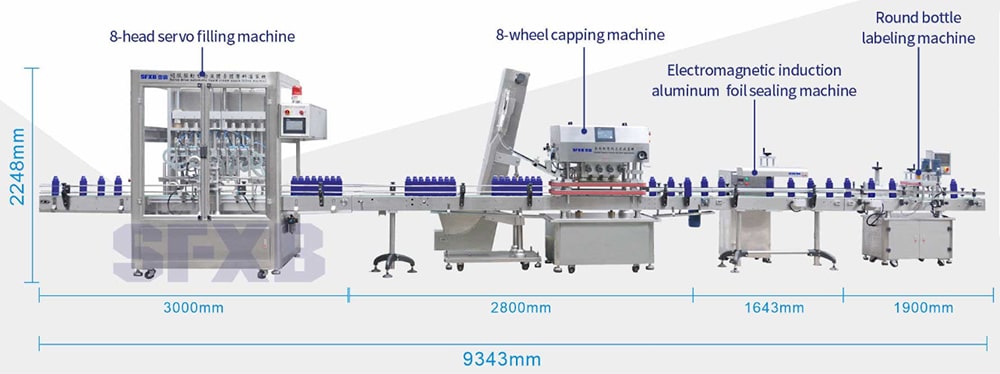 |
| XBGZ-500-12 Fully automatic 12-head servo paste filling machine-capping-sealing-labeling production line
Filling of various liquids, pastes, sauces (including soft particles), strong versatility |
Key Considerations for Choosing a Paste Filling Machine
When selecting a paste filler, match the machine to your product and production needs. Key factors include:
● Production Volume: Estimate your hourly and daily throughput. If only a few hundred units/day, a semi-auto or small bench filler may suffice. For >1,000 units/hour, a multi-head automatic is warranted. Note that higher output usually requires more filling heads and a larger footprint.
● Product Viscosity and Consistency: Know the viscosity (in cP) and particulates in your paste. Very high viscosities (>100,000cP) favor piston or lobe pump fillers with strong drives. If the product has large particles or fibers, a pump filler (or even a granular filler) may be needed. Request samples of the machine handling your product to ensure it flows (or is pumped) correctly.
● Filling Accuracy and Repeatability: Determine fill tolerance (e.g. ±1mL). Piston and servo-driven machines achieve very tight tolerances. Peristaltic and time-based pumps may have slightly lower precision but are often sufficient for sauce/jam filling.
● Container Types and Sizes: List all container forms (tube, jar, bottle, pouch) and sizes you’ll use. Some machines handle only rigid containers, others can do flexible pouches or tubes. Check the changeover between sizes – modular machines allow nozzle/tool swaps, whereas highly integrated lines may need more setup.
● Cleanability and Maintenance: Paste can dry on surfaces, so machines must be easy to clean. Look for hygienic design (SUS316 or SUS304 stainless steel, smooth welds), and features like quick-release pumps/nozzles. Inline or CIP (clean-in-place) systems help, but most paste machines require manual disassembly of paste-contact parts. As one supplier advises: clean all parts thoroughly and regularly… especially for paste, which can dry and solidify on moving parts. Verify that pumps and valves can be flushed or removed for cleaning (hot water or solvent wash-out). Also consider lubricants: moving parts should use food-grade or compatible lubricants if for edible products.
● Flexibility: If you plan to expand product lines, choose a machine that can adapt (e.g. variable speed, interchangeable nozzles, adjustable fill ranges). Semi-auto machines often allow easy resizing for new containers. Fully automatic machines may need extra tooling for different formats.
● Regulatory Requirements: For food or pharma uses, machine materials and construction must meet GMP/food safety standards (tri-clamp fittings, CIP, sanitary design). Check certifications (CE, UL, ISO, etc.). For explosive atmospheres, ensure ATEX or NEC compliance.
● Budget and ROI: Balancing cost vs need is crucial. More complex machines cost more. Typical price influences include number of heads, automation, controls, frame size, and brand. Remember to include auxiliary costs (conveyors, compressors, installation, training).
● Support and Service: Given the complexity of these machines, good manufacturer or integrator support is key. Look for suppliers with experience in your industry (food vs cosmetics vs chemicals). Local service availability and spare parts supply will affect uptime.
Paste Filling Machine Applications
Paste filling machines serve many industries:
● Food & Beverage: Peanut butter, jams, jellies, sauces (ketchup, mustard, mayonnaise), honey, fruit purees, dairy spreads, and more. Food paste fillers must be food-grade stainless steel and hygienic. They often include scrubbing or vacuum features to deaerate foamy products (e.g. aerated chocolate). For example, jam and sauce filling machines are common in small food factories. A sauce filling line might include a hopper with agitator, piston pumps, and a high-speed rotary filler for bottles or tubs.
● Cosmetics & Personal Care: Creams, lotions, balms, scrubs, ointments, gels, makeup (foundation), shampoos, toothpastes. Cosmetic fillers focus on precision (to maintain batch consistency) and low shear (to preserve emulsions). They often handle small to medium containers (jars 30–500mL, tubes, bottles). Small cosmetic cream filling machines (5–25 bottles/min) allow small brands to bottle in-house. For example, hand cremes, body lotions, and eye ointments are filled on piston or pump fillers. Tubes (toothpaste, masks, serums) use tube fillers that align and seal each tube.
● Pharmaceuticals: Ointments, creams, gels, gels (like ultrasound gel, medicated creams). Accuracy and cleanliness are paramount. Paste fillers here often have fine volume control and may operate in cleanroom environments. Aseptic or closed systems may be required (especially if there is biocide content).
● Household & Industrial Chemicals: Paints, adhesives, sealants, lubricants, waxes, grease cartridges. These pastes can be very viscous and abrasive (e.g. industrial grease). Filling machines for these products use heavy-duty pumps or cams. Explosion-proof designs might be needed if solvents are present. For example, a grease filler could fill cartridges and drums with high-viscosity lubricant. For lighter cleaning products (cream cleaners, polishes), simpler piston fillers suffice.
● Others: Niche uses include filling k-cups (coffee pods with ground coffee paste), cannabis extracts (thick oils/creams), wax melts, etc. Essentially any sector needing precise paste dosing can use these machines.
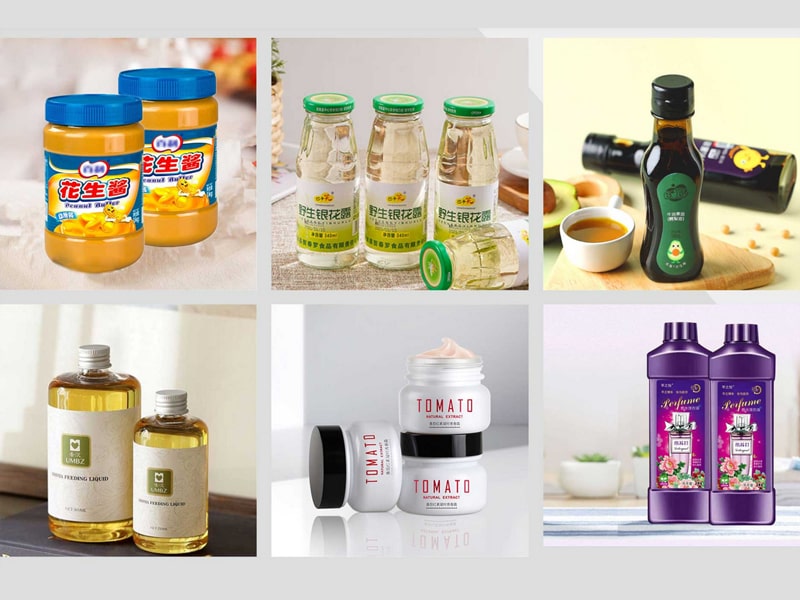 |
| Paste Filling Machine for various liquids,pastes,sauces and cream including soft particles |
In short, nearly any paste-like product finds a filling machine solution. The container style often depends on industry: food uses jars and pouch packs; pharma uses tubes and ointment jar; cosmetics uses jars, tubes, and custom bottles; chemicals use cartridges, drums, or sachets. Machine vendors often categorize their fillers by industry to ensure compatibility (food-grade seals vs chemical-resistant coatings, etc.).
Overview of Paste Filling Technologies
Paste fillers use different technologies to meter product. Choosing the right one involves matching to product properties:
● Piston (Volumetric) Filling: Draws product into a cylinder and then dispenses it. This is the classic approach for high-viscosity liquids. It provides consistent volume dosing. Rotary piston machines (turrets) allow multiple fills per cycle. When driven by a servo motor, they can easily adjust stroke length on the fly. Piston fillers work for most pastes (creams, ointments, ketchup) with moderate wear on parts. They are also used for low-viscosity liquids (just larger cylinder).
● Auger Filling: Typically used for powders or granular products. Not common for pastes, unless the paste has significant solids or is powdery when dry (e.g., dry shampoo fill). Auger fillers use a rotating screw to dispense consistent weight/volume.
● Pump Filling (Rotary Lobe, Gear, Peristaltic): As discussed, pump fillers move product with rotating lobes or squeeze tubes. They are excellent for chunky or very thick pastes. A positive displacement pump (like a worm or lobe pump) can push viscous paste reliably. Modern paste fillers often use such pumps with a separate fluid-actuated piston or screw pump for volumetric control.
● Ceramic Pumps: In high-precision paste fillers (often cosmetics or pharmaceuticals), ceramic plunger pumps are used. Here, the pump plungers or pistons are made of ceramic material (alumina or zirconia). These ceramic plungers are extremely hard and corrosion-resistant, giving very stable accuracy over time. A ceramic pump filler might handle aggressive chemical lotions or very fine cosmetic serums with minimal wear on the pump.
● Gravity/Overflow Filling: Mostly for low-viscosity fluids and not typical for pastes. A related concept is vacuum filling, where product is drawn under vacuum before dispensing to reduce air inclusion. Some cosmetic fillers use vacuum-assisted filling for foamy creams (not strictly gravity, but similar goal).
● Servo-Controlled Motion: Modern paste fillers employ servo drives in two ways: (1) to drive the piston/pump for precise volume control, and (2) to control conveyors and indexing. Servo-driven fillers allow variable speed profiles. For viscous or foaming pastes, they can start fast then slow down to reduce air entrapment. By comparison, pneumatic piston fillers run at a fixed cycle speed determined by air flow, which may not be optimal for all products.
● User Interface and Automation: Higher-end machines include recipe storage (for quick changeover), touchscreens, and feedback sensors (load cells or flow meters) to verify fill weight. Basic machines may only have manual knobs for volume adjustment.
Given these options, an SME buyer should consider: Is my product best pushed by force (piston), pulled by pump (lobe), or allowed to flow by gravity? As a rule: water-thin juices use gravity, medium-viscosity lotions use piston, and ultra-thick or particulate pastes use pumps.
Maintenance and Operational Tips
Paste filling machines require diligent maintenance due to the nature of the product. Key tips include:
● Clean Thoroughly and Frequently: Paste will dry and crust on surfaces. Dismantle contact parts (nozzles, pistons, hoses) after each shift if possible. Wash with warm water or suitable solvents to remove residues. Don’t let paste harden on valves or in pump chambers.
● Lubrication: Follow manufacturer guidance on lubricating bearings, gearboxes, and pneumatic cylinders. Use recommended food-grade or chemical-compatible lubricants. Check oil or grease levels regularly.
● Pump and Seal Inspection: Check pump seals, gaskets, and O-rings regularly. Paste can abrade seals or chemical ingredients can degrade them. The SunhanPACK guide notes that ceramic pump seals are more wear-resistant, but any seal has finite life. Replace worn parts before they fail.
● Calibration Checks: Periodically verify fill volume by weighing samples. Even servo systems can drift slightly over thousands of cycles. Make small volume adjustments as needed.
● Compressed Air Maintenance: For pneumatic systems, ensure air filters, dryers, and regulators are in good shape. Moisture or oil in compressed air can spoil the paste and damage components.
● Belts and Motion System: On conveyor-driven machines, inspect belts and chains for wear and tension. Worn belts can cause synchronization issues between filling, capping, and indexing.
● Electrical/Control Check: Look for loose wires or failing sensors that could cause misfills. Ensure emergency stops and safety guards are operational.
● Clean-In-Place (CIP) Features: Some large fillers have CIP spray balls or flush systems. Use these regularly to auto-rinse internal surfaces, but still perform manual disassembly when thorough cleaning is needed.
Overall, the operator’s training is critical: paste filler maintenance is more demanding than for watery liquid fillers. As one industry guide notes, clean paste handling parts more frequently since paste tends to dry and build up quickly.
Conclusion
Selecting the right paste filling machine requires a strategic approach grounded in technical understanding and practical application demands. By carefully assessing product characteristics, container types, machine technologies, and operational goals, businesses can secure packaging solutions that enhance quality, efficiency, and market competitiveness. Companies like SFXB provide versatile, high-precision machines—from pneumatic to fully automated servo-driven systems—that cater to diverse paste filling needs worldwide.
| References: | |
| 1. | Paste Filling Machine Market Report ——Retrieved from:DataIntelo |
| 2. | Paste Filling Machine Guide ——Retrieved from:SourcifyChina |
| 3. | Filling Machines Selection Guide——Retrieved from:Globalspec |



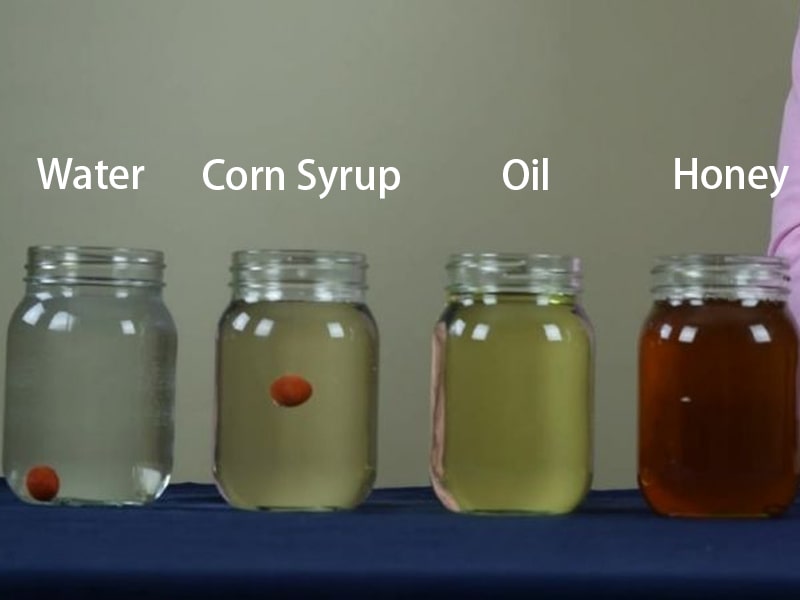



Comments